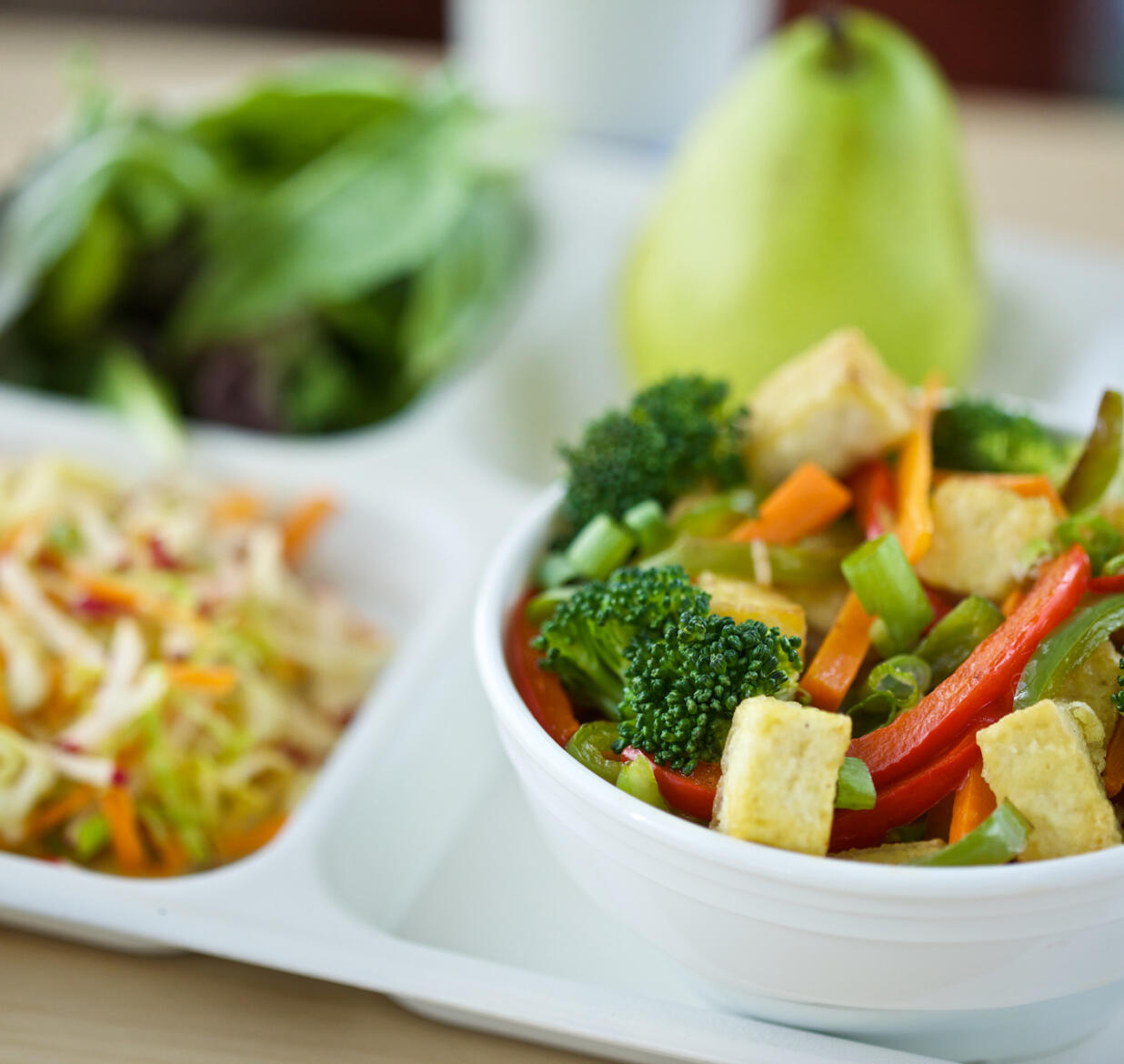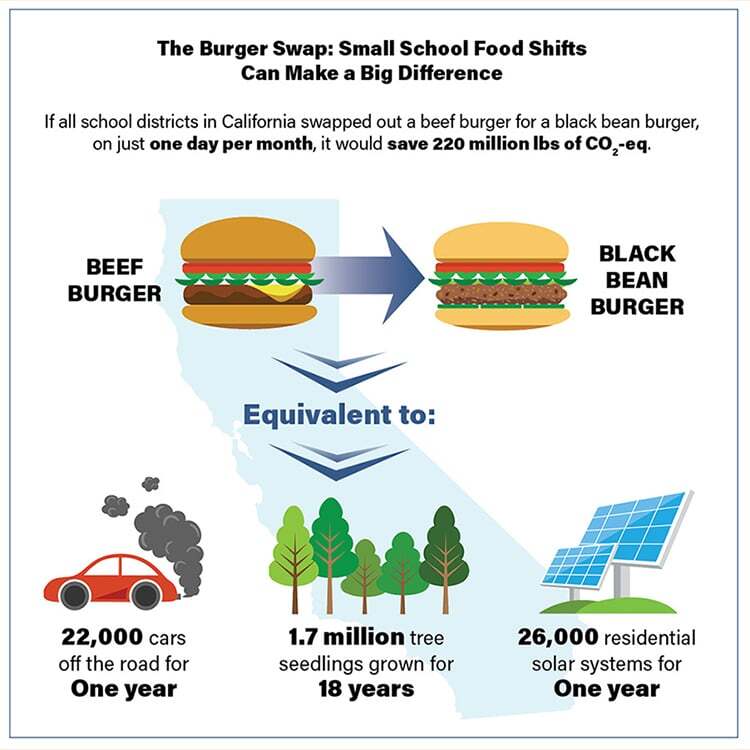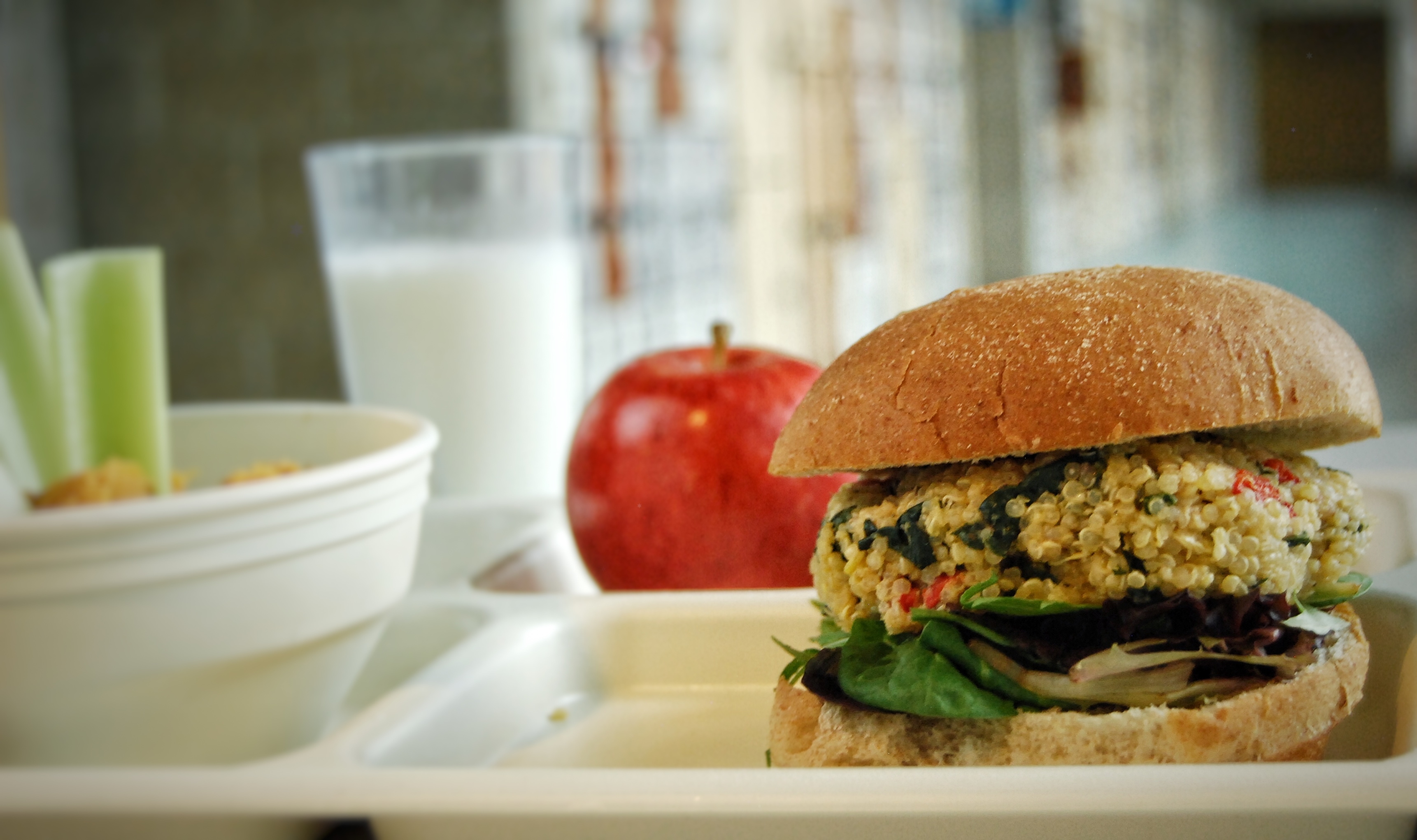
Sustainability & Scratch Cooking: How We Can Work Towards a Better Earth Through School Food
April 19, 2021 | By Allison Ildefonso
With Earth Day approaching on April 22nd, we were inspired to share how scratch cooking in schools can play a pivotal role in creating a more environmentally sustainable food system—and better world for all.
Earth Day is just around the corner, which means it’s the perfect time to start thinking about the environment (if you weren’t already!) and how school districts can implement sustainable practices—including scratch cooking.
Environmental sustainability refers to responsible interaction with the environment, in order to avoid depletion or deterioration of natural resources. Carrying out environmentally sustainable practices is a critical way to combat climate change, which is evident through relatively recent increases in global land and ocean temperatures; ice loss; as well as frequency and intensity of hurricanes, heatwaves, wildfires, droughts, and floods.
“The United Nations intergovernmental panel on climate change has warned that we have less than a decade left to mitigate climate change to the point where we won’t have a mind blowing, devastating shift in the world,” says Chloe Waterman, Climate-Friendly Food Program Manager for Friends of the Earth.* “We would see the toughest inequalities rearing their ugly heads. We’d see people who are already the most marginalized—the poorest people of color—hit first and hit worst.”
To Waterman’s point, doing our part for the environment is vital to the health and wellbeing of future generations and the earth. With more than 30 million children participating in the National School Lunch Program (NSLP), that’s 30 million opportunities to make lasting change and build the world we want to live in.
So, how do scratch cooking and sustainability connect to each other, let alone school food? Here, we’re highlighting key ways that districts can start prioritizing sustainability and the power that comes with cooking school meals from scratch.
Scratch Cooking and Sustainability
“The most important school supply in the world is food,” says Stephen Ritz, founder of Green Bronx Machine.* “Introducing children to real, scratch-cooked food and a healthy balanced plate is brilliant.”
Research shows that children who are exposed to healthy, fresh food and a salad bar in school consume more fruits and vegetables over the course of their lives. As the nation’s leading scratch-cooked school food experts, the Chef Ann Foundation knows the power of using fresh, whole ingredients to feed kids. But why is scratch cooking so important?
“Good quality food in schools helps stabilize food security and health and wellbeing. The farm to school movement has done a good job documenting that with better quality food, kids are better able to pay attention and participate in school, and generally see an increase in performance.”
As we cover in this section of our website, school food has become increasingly more processed and less healthy over the past few decades, with tons of filler ingredients, preservatives, and artificial ingredients. The result? Obesity rates in both children and teens have increased to 18.5%—which equates to 13.7 million kids eating highly processed, high-calorie meals with few nutrients.
“Good quality food in schools helps stabilize food security and health and wellbeing,” says Laura Edwards-Orr, Director of Institutional Impact for the Center for Good Food Purchasing.* “The farm to school movement has done a good job documenting that with better quality food, kids are better able to pay attention and participate in school, and generally see an increase in performance.”
Scratch cooking involves using recipes and real ingredients, and when schools focus on building recipes, all items can be fully controlled. This means school food professionals can prioritize high quality, nutritious, and local ingredients much easier than other pre-packaged options.
“That translates into procurement power and increases the opportunity for schools to partner or collaborate with local businesses,” says Edwards-Orr. “Institutional purchasing dollars spent within the local economy has the opportunity to increase the number of jobs and wages in their areas. It also offers an opportunity for food services staff and students to become engaged in their local or regional economy and to learn about who these suppliers or businesses are. I’ve certainly seen in scratch cooking districts we’re working with using that as an opportunity to collaborate and develop items together.”
On a similar note, Ritz also attested to the relationship between scratch cooking and local economic benefits: “According to the New York State Department of Agriculture, for every dollar spent on the local ecosystem, that dollar is passed on eight more times locally. Local procurement generates hyperlocal concentric circles of success.”
There are, however, some potential barriers to scratch cooking that school districts and food service teams should consider; particularly the necessity of kitchen space and trained staff. Making the transition from heat-and-serve, processed food to scratch cooking also takes time and patience, as Bertrand Weber, Director for Minneapolis Public Schools (MPS) Culinary and Wellness Services,* can attest to.
“It took quite a while to transition from pre-packaged food, to semi-scratch, to full-scratch and where we’re going to be next year,” Weber says.
To learn more about how Chef Ann Foundation programming can support school districts on their journey to scratch cooking, click here.
Plant-Forward Meals
Of course, scratch cooking and local procurement have environmental benefits as well. According to Edwards-Orr, scratch cooking can act as a lever for increasing sustainability in institutional cooking because of the potential to decrease the amount of animal products purchased in a given year, which is much easier to do if cooking from scratch. This is either by replacing animal proteins with plant proteins, or buying better meat in less quantity. But it’s important that plant forward menu options also be tasty, “because a black bean burger in the trash is not a victory,” says Waterman. “We want to make sure that they’re kid-tested, which is one of the things we love about Chef Ann Foundation—all Chef Ann recipes are kid-tested and likely to work well in a cafeteria environment.”
Plant based proteins like beans, tofu, and tempeh are all creditable in the USDA meal pattern and can be nutritious and environmentally friendly additions to school food menus. Incorporating plant forward menu options into a school food operation has the potential for real, positive implications on the environment (since plants take fewer resources, such as water and energy, to produce than meat), as well as student health and school food finances. Friends of the Earth has completed several analyses of the environmental impact of meat in schools, most recently their examination of school menus in California (see graphic from this report to the right).


Plant based proteins like beans, tofu, and tempeh are all creditable in the USDA meal pattern and can be nutritious and environmentally friendly additions to school food menus. Incorporating plant forward menu options into a school food operation has the potential for real, positive implications on the environment (since plants take fewer resources, such as water and energy, to produce than meat), as well as student health and school food finances. Friends of the Earth has completed several analyses of the environmental impact of meat in schools, most recently their examination of school menus in California (see graphic from this report to the right).
Furthering Sustainability in Schools
There are a variety of ways for schools to implement sustainable practices in their food service operations, outside of scratch cooking, local procurement, and incorporating plant forward menu options. Some of these strategies include purchasing and installing bulk milk machines, using bulk containers for condiments instead of single-serve, replacing styrofoam products with recyclable or compostable ones, and utilizing reusable trays that are dishwasher safe. All of these options are environmentally-friendly and promote limited waste. We understand much of these initiatives were challenging due the pandemic and had to be on hold. However, now is a great time for districts to start thinking about the next school year!
The Good Food Purchasing Program is built on the principles of local economies, nutrition, valued workforce, environmental sustainability, and animal welfare. These standards provide a “metric-based, flexible framework” to encourage schools and other large institutions to direct their buying power towards these core values. While an aspirational model, the Chef Ann Foundation believes it is within reach for school districts to strive toward these pillars, even if it means starting with small changes and building upon them.
Through years of planning and effort, Weber and the Culinary and Wellness team at MPS are currently following all the GFPP pillars. “We believe in those values, so we align ourselves with producers and manufacturers that have environmental practices in place,” Weber says. “We have embedded GFPP in all of our RFPs (Request for Proposal) to make sure whatever we purchase follows those guiding principles.”
Weber’s team was in the process of installing 10 bulk milk machines before COVID hit and everything came to a stop; however, those will be rolling out next year. They’re also sourcing as much as possible from minority and women-owned businesses, using high energy recycled water, reducing the amount of single-use packaging and individually-wrapped items, and increasing reusables since all of the district’s new kitchens include a dishwasher.
“I feel really good about it,” Weber says. “It really showcases to our students that not everything has to be disposable.”
Tips for Getting Started
If you’re part of a school district that aspires to adopt a more environmentally friendly operation, there are several small but mighty ways to get started. Our friends at Friends of the Earth suggest starting with analyzing your district’s procurement of red and processed meat, which both have high emissions and are linked with diet-related diseases. Processed meats, according to Waterman, are known carcinogens—substances capable of causing cancer in living tissue.
Switching out one menu item per week (or simply offering and marketing an alternative) could be a great starting point for many school districts. For example, a beef patty swapped out for a lentil or bean-based patty, or a chicken stir fry could be offered with a tofu alternative. Click here for plant forward recipes on The Lunch Box, including kid favorites like vegetable lasagna and quinoa burgers.
Switching out one menu item per week (or simply offering and marketing an alternative) could be a great starting point for many school districts. For example, a beef patty swapped out for a lentil or bean-based patty, or a chicken stir fry could be offered with a tofu alternative. Click here for plant forward recipes on The Lunch Box, including kid favorites like vegetable lasagna and quinoa burgers.


Switching out one menu item per week (or simply offering and marketing an alternative) could be a great starting point for many school districts. For example, a beef patty swapped out for a lentil or bean-based patty, or a chicken stir fry could be offered with a tofu alternative. Click here for plant forward recipes on The Lunch Box, including kid favorites like vegetable lasagna and quinoa burgers.
Waterman says marketing is the key to getting kids to try new, healthier options because they’re more inclined to go with what’s familiar unless given the chance to try it first, no obligations. A key marketing tactic is to have tasting days in the cafeteria during which students can vote for whether they “liked, loved, or disliked” an item. Similarly, one of the most impactful things schools can do is use an offer versus serve model, where students decide what they want to take.
“We recognize these changes can’t happen overnight,” Waterman says. “I definitely suggest starting to serve plant-based options alongside meat options.” Another suggestion is to create blended recipes; for example, a beef and mushroom burger with a smaller amount of beef but the familiar taste and feel.
According to Edwards-Orr, the number one thing to do is get started. “It’s almost impossible to figure out what you want to change and how if you don’t have a good perspective or insight into what’s going on right now,” she says. Edwards-Orr and the Center for Good Food Purchasing encourage a baseline assessment as a starting point to understand your program and leverage what you learn to set goals and strategies that match your district’s values.
Tying It All Together
Waterman attests that while food is certainly a driver of climate change, it is also a solution. Schools, she says, have a huge role to play in shifting toward more climate friendly diets and reducing food waste. Within federal requirements, schools have the flexibility to offer more climate friendly choices and foster healthier students in the process.
At the Chef Ann Foundation, we hope this Earth Day inspires you to take a deeper look at how individual and collective actions have the power to shape the world we live in and how we live in it.
“School food has the opportunity to do right by students in making sure that their cafeterias are aligned with their values,” Waterman says, “If our job is to really safeguard the health and wellbeing of students, that means fighting climate change. We have a duty to this generation of students to not only feed them nutritious meals so they‘re ready to learn and pay attention in their classrooms every day and don’t feel hungry, but also because those meals set kids up for a world that is safe for them to live in.”
*The Chef Ann Foundation collaborated with the Center for Good Food Purchasing, Friends of the Earth, Green Bronx Machine, and Minneapolis Public Schools to compile the information for this blog. For more on each of these organizations/institutions, see below:
The Center for Good Food Purchasing provides a comprehensive set of tools, technical support, and verification system to assist institutions in meeting their Good Food Purchasing Program goals and commitments. Click here to learn more.
Friends of the Earth strives for a more healthy and just world. FOE understands that the challenges facing our planet call for more than half measures, so they push for the reforms that are needed, not merely the ones that are politically easy. Click here to learn more.
Green Bronx Machine is an impact driven, for-purpose organization. Originally an after-school, alternative program for high school students, Green Bronx Machine has evolved into a K-12+ model fully integrated into core curriculum. Click here to learn more.
Minneapolis Public Schools Culinary and Wellness Services serves True Food that tastes good without high fructose corn syrup, trans fats, artificial colors or preservatives. Click here to learn more.







